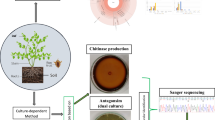Abstract
In a series of studies on the distribution of alkalophilic and alkali-tolerant fungi, soil fungi were isolated from five alkaline calcareous soil samples in two closely located limestone caves (stalactite caves) in Japan using slightly acidic and alkaline media. Some common soil fungi that can grow in alkaline conditions were obtained in high frequencies. The growth response to pH of the isolates revealed that approximately one third (30.8%) of the isolates had the optimum pH in the alkaline range. All isolates of fourAcremonium species and twoChrysosporium species grew well in alkaline conditions, of whichAcremonium sp. andChrysosporium sp. were pronounced alkalophiles. These fungi were thought to be indigenous species in this alkaline environment. The fungal flora in the Japanese alkaline soils was considerably different from the flora reported in alkaline environments in other countries.
Similar content being viewed by others
Literature cited
Bååth, E., Lundgren, B. and Söderström, B. E. 1984. Fungal populations in podzolic soil experimentally acidified to simulate acid rain. Microbial Ecol.10: 197–203.
Gams, W. 1992. The analysis of communities of saprophytic microfungi with special reference to soil fungi. In: Fungi in vegetation science, (ed. by Winterhoff, W.), pp. 183–223. Kluwer Academic, Dordrecht, the Netherlands.
Griffin, D. M. 1960. Fungal colonization of sterile hair in contact with soil. Trans. Br. Mycol. Soc.43: 583–596.
Mukerji, K. G. 1965. Ecological studies on the microorganic population of usar soils. Mycopath. Mycol. Appl.29: 339–349.
Nagai, K., Sakai, T., Rantiatmodjo, R. M., Suzuki, K., Gams, W. and Okada, G. 1995. Studies on the distribution of alkalophilic and alkali-tolerant soil fungi I. Mycoscience36: 247–256.
Nicholls, V. O. 1956. Fungi of chalk soils. Trans. Br. Mycol. Soc.39: 233–238.
Pugh, G. J. F. and Dickinson, C. H. 1965. Studies on fungi in coastal soils. VI.Gliocladium roseum Bainier. Trans. Br. Mycol. Soc.48: 279–285.
Rai, J. N., Agarwal, S. C. and Tewari, J. P. 1971. Fungal microflora of ‘usar’ soils of India. J. Indian Bot. Soc.50: 63–74.
Stenton, H. 1953. The soil fungi of Wicken Fen. Trans. Br. Mycol. Soc.36: 304–314.
Tribe, H. T. 1957. Ecology of micro-organisms in soils as observed during their development upon buried cellulose film. In: Microbial ecology (7th Symp. Soc. Gen. Microbiol.), (ed. by Williams, R. E. O. and Spicer, C. C.), pp. 287–298. Cambridge Univ. Press, Cambridge.
Warcup, J. H. 1951. The ecology of soil fungi. Trans. Br. Mycol. Soc.34: 376–399.
Author information
Authors and Affiliations
About this article
Cite this article
Nagai, K., Suzuki, K. & Okada, G. Studies on the distribution of alkalophilic and alkali-tolerant soil fungi II: Fungal flora in two limestone caves in Japan. Mycoscience 39, 293–298 (1998). https://doi.org/10.1007/BF02464011
Accepted:
Issue Date:
DOI: https://doi.org/10.1007/BF02464011




